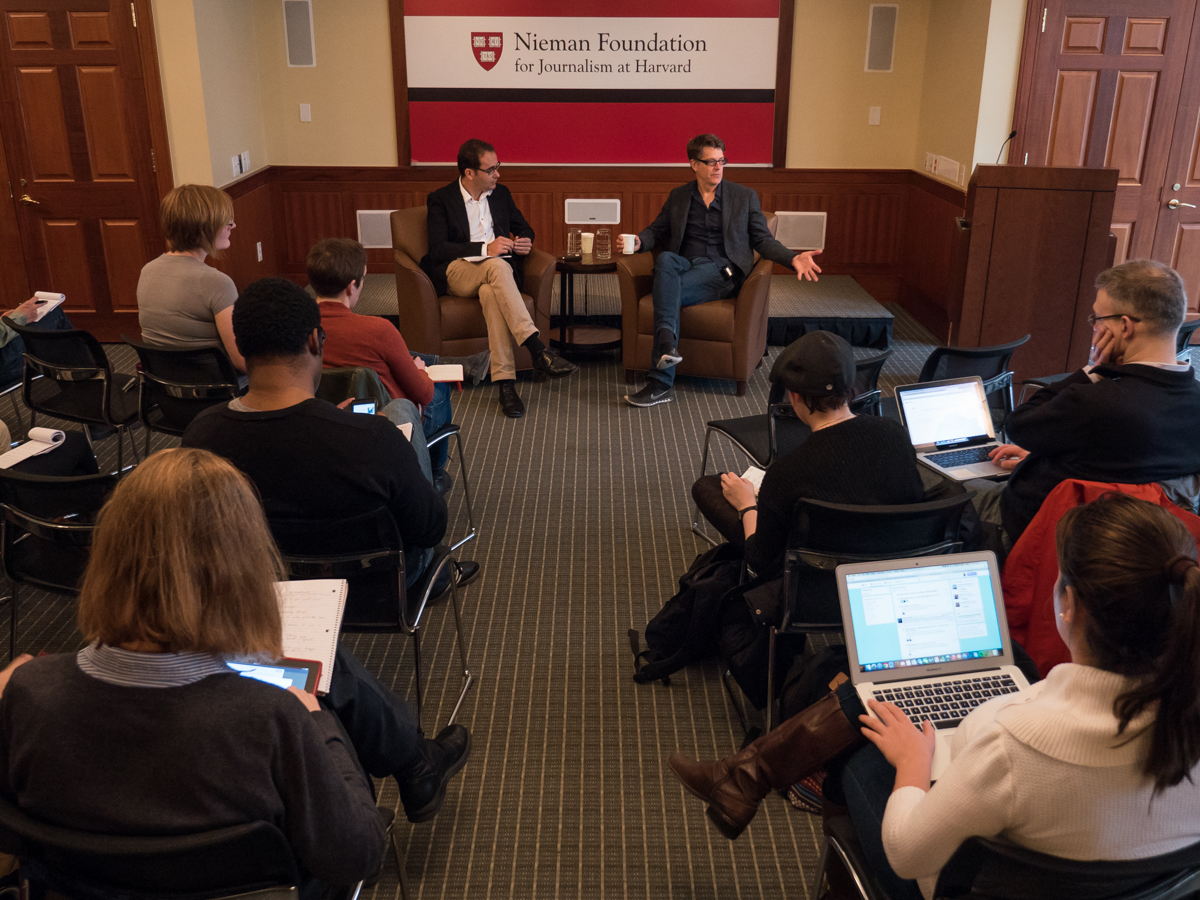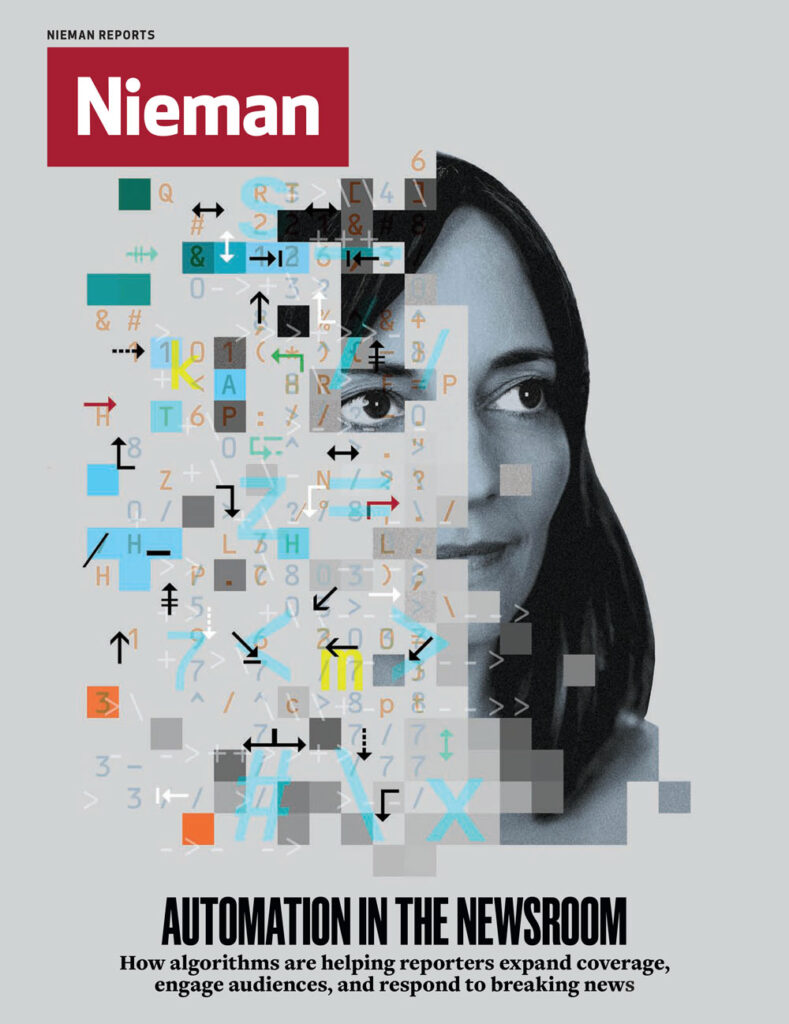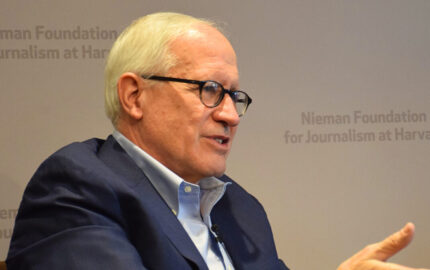With a clean, simple design, Medium aims to change the way people write, publish, and read online. In three years, Medium has evolved and now features content by both amateurs and professionals—not just journalists and novelists, but politicians and policymakers as well. President Obama’s 2015 State of the Union was published on Medium, and Walter Isaacson published a portion of his latest book, “The Innovators,” on the platform. Medium today publishes two branded publications: Backchannel, about technology, and Matter. In July, the site had 28 million unique visitors globally, according to internal metrics.
Medium is not without critics, especially among freelance writers. Out of several thousand articles posted on the site each day, Hansen recently estimated that Medium pays for about 50 or fewer. The unpaid writers retain the copyright to their work.
Hansen spoke at the Nieman Foundation this spring in conversation with David Jiménez, a 2015 Nieman Fellow. Edited excerpts:
On creating engagement
As a writer, you want more than a nice easel. You want an audience and ultimately, you want to get paid. At Medium, the first piece of the puzzle was to make a much more elegant and appealing tool for writing and to create an environment where readers will take the time to pause and engage with the words in front of them.
You want that instead of creating all this clutter, what I used to call “link roulette” when I was at Wired. We were convinced that the stories people were reading wouldn’t keep their attention for more than a couple seconds, or maybe a minute if we were lucky. So we’d say, “Let’s put 40 other links up there. The minute they get bored with this one, they’ll click off, and they’ll stay with Wired.”
I think you start to see some of the seeds of why writing is broken on the Internet. Reading is an experience in which you’re engaging with another mind. The engagement between an author and a reader was getting severed, so at Medium we wanted to reconnect those dots.
The method for doing that, in addition to creating the tools, was to create a network, a place where people engage with each other and not just with documents. It took Facebook and social networks to realize that the real unit of exchange is not documents, it’s people.
The real workhorse of Medium is the network. It’s the people on it reading, recommending, interacting. It’s not a top-down process
On algorithms and editors
When you try to curate vast amounts of information, you run into a scaling problem. People are a better judge of individual pieces of content than algorithms, but when you’re trying to review thousands of pieces of content in real time and make suggestions about what to read, it gets to be a problem.
I think ultimately it’s a combination of people plus machines. What the algorithms are doing, though, is fundamentally responding to what humans are doing with the content.
On optimum story length
We ran some numbers to figure out if there’s an optimal length for writing on Medium in terms of people finishing a story. Our data scientists assured me that seven minutes is the ideal reading time for a post.
Two years ago, when Medium really took off, there was a resurgence of interest in long-form writing. Medium acquired an investigative science journalism magazine called Matter, which was publishing one long-form story once a month. We got associated with the long-form movement, largely as a result of that.
Yet we accept any type of writing as long as it fits our terms of service. Shorter stuff is great. Long does not always serve the reader better. Very few stories actually rise to the level of needing 10,000 words. The idea is to publish stuff that is shorter, conversational, and ephemeral without displacing or removing long-form.
On (not) paying writers
I think there’s a whole range of motivations for people to write. You have amateurs who are trying to get their name out there. Having an open platform where their stuff might get noticed and seen by a big audience is very appealing.
You have people who have stories that they want to get out to the public and they want to own that relationship and their own words. Then on the far end of the scale, you have professional writers who write to put bread on the table. Even they have a range of motivations for writing certain things.
Writers will happily publish on The New York Times op-ed page and they don’t always get paid. They get huge reach for their stuff. There’s a whole kind of calculus that you do in terms of “Am I building my brand as a writer?” versus “Am I getting paid?”
There is the notion that you get paid for the words that you write, and I understand that freelancers don’t want to get taken advantage of, but there’s a ton of reasons why people would get value out of putting things up on a platform like Medium for free.
On finding a revenue model
Our long-term goal is to build a platform that rewards writers for being there. We want to build revenue-creation tools in a way that, say, YouTube has done for video creators. We want to do that for writers and give people a bigger cut of the pie.
We haven’t considered what our most potent revenue model will be in the long run. We’re a broker between creators and audiences. It could be that we’re connecting professional writers, designers, photographers, and illustrators, and giving them a marketplace where they can connect with customers at scale, so if you’re a photographer maybe you can license your image to hundreds of people for a dollar each.
We also act as a creative service agency for brands, like BMW. For them, we launched a site called re:form. They had a very high interest in associating their brand with design so they deputized us to build them a high-quality publication around design. We hired an editor who hired journalists to write stories about design. BMW is never mentioned once. We labeled the stuff, saying, “Hey, this is sponsored by BMW,” and everything’s aboveboard, but it’s a different model of advertising. [Medium has since stopped publishing on its re:form site and the BMW sponsorship logo was removed.]
What’s different about our model is not that we’re trying to compete with, say, The New York Times or any media company. Ultimately, we want to be a place that serves those companies, that tells them, “Hey, you’re going to get value out of publishing on Medium even if you’re a major media brand.”
We’re not gearing our tools to that particular customer now but in the long run, that makes sense for us. We don’t want to be competing with writers or publishers. We’re competing with other people who provide tools for publishing on the Internet.
On the value of publishing on Medium
When you post on Medium, you have followers. People recommend your article. We have algorithms that then will progressively show it to more people. The more recommended it gets, the more it pushes up or goes out in an e-mail blast and so on.
That’s the fundamental dynamic of distribution that we’re trying to build. We have a few levers that we can pull. We have an @Medium Twitter account and a Medium Facebook account. We populate the homepage with a human-curated list of stories.
We’re putting about 25 to 30 stories [that number has since dropped to five to 10] a day on the homepage and maybe tweeting the same number of posts and oftentimes, they’re the same ones. The real workhorse of Medium is the network. It’s the other people on it, reading, recommending, interacting. That creates the amplification. It’s by design supposed to be very organic and not a top-down editorially driven process. It’s bottom-up based on readers.
Writers can see who follows you. If people follow you, there’s a notification sent out to that group of people every time you publish something and every time you recommend something. You can drill in to see who’s following you.
Medium gives an opportunity to a young writer to get noticed by people in a way that you might never have a chance to get noticed otherwise.
One of my favorite stories about people whose lives have literally been changed by publishing on Medium is about a 19-year-old who wrote a post concerning how teenagers use social media. Our tech editor, Steven Levy, noticed that piece, asked the kid whether he would like to put that post in Backchannel, which is our in-house technology publication. He said “Yes.” He was ecstatic first of all that Steven Levy had noticed it. We paid the guy for it. The post exploded. It owned the Internet for a day. Then, TechCrunch called him up. They said, “We want to interview you. We want to introduce you to some people at our start-up.” He flew out and met all these people. He got an internship at a company he would never have had access to before.
I think this notion that the value of writing is inherently the dollar that’s spent on the word is mistaken. In fact, everyone who has written a book would say that the value of the book isn’t necessarily the revenue they got from selling the book, but it’s all the opportunities they got from the speaking engagements and other things.
For a lot of people, writing might be a loss leader for other things. Distribution, marketing, attention—they may be way more valuable to you than a dollar.




